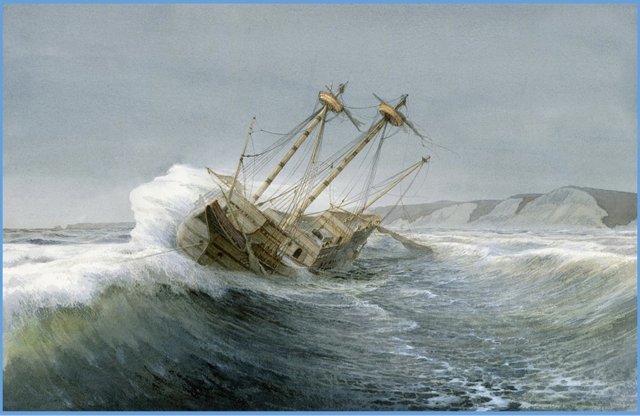
Two shipwrecked Spanish galleons lie beneath the waves on the U.S. West Coast. Both were carrying valuable cargo that would be worth many millions of dollars today. Researchers know the areas where these ships went down and could pinpoint the locations using modern technology. But the ships and their secrets may never be revealed. Are they more valuable sitting under the waves?
“Time and tide wait for no man.” Geoffrey Chaucer
The San Agustin was wrecked in a storm in 1595, just north of San Francisco, California
In 1595, a Spanish galleon named the San Agustin left Manila. Sponsored by some of the richest traders in the Philippines, the 200-ton ship was filled to the brim with silks, spices, gems, Ming dynasty porcelain, and other treasures of the Orient. In today’s dollars, its cargo was valued at half a billion dollars. If salvaged today, its cargo would be worth several million dollars at least.
The San Agustin was bound for Acapulco, Mexico, but it never arrived. Instead, the ship was wrecked in a harbor called Drake’s Bay in Northern California, becoming the oldest known shipwreck on the U.S. West Coast. The ship had been in bad condition and had stopped at Drake’s Bay (just north of San Francisco) because the harbor was protected from the prevailing west winds. Yes, it’s the same bay where Sir Francis Drake came ashore in 1579, according to most historians.
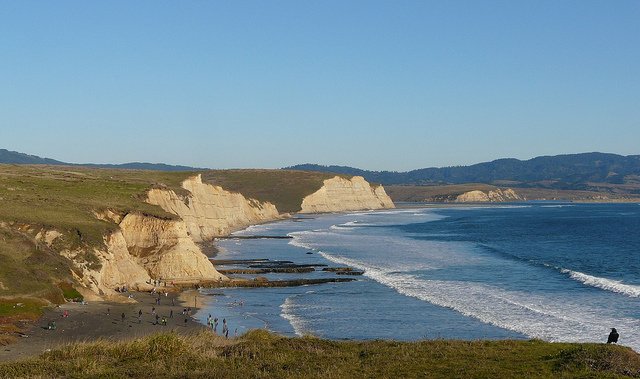
Image: Drake’s Bay. Creative Commons via Flickr by mksfca.
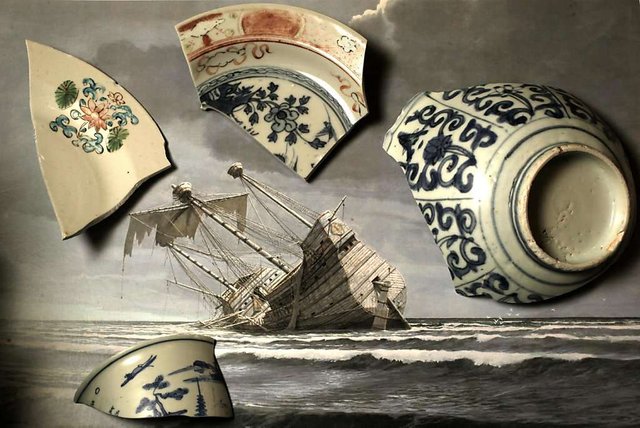
Image: Ming pottery from a galleon wreck in Baja California. San Francisco Chronicle.
Unfortunately for the San Agustin , a storm coming up from the south surprised them and wrecked the galleon. They decided to leave it.
The ship’s captain, 70-75 crewmembers, and a dog not only survived the wreck, but squeezed themselves into the small launch boat and made their way down the coast. The men ate the dog, ate some of a beached whale they found, scavenged a few other things, and rowed and walked their way down the California coast.
Eventually, 1500 miles (2400 kilometers) later, they arrived in Spanish Mexico. The men were starving, but amazingly they had not lost a single person.
The Wax Galleon
Almost 700 miles (1100 kilometers) to the north, off Nehalem Bay in Oregon, chunks of wax have been washing ashore for centuries. As early as 1813, there were accounts of a fur trader being offered wax by Native Americans in the area, even though Oregon had no native honeybees. Some of the wax blocks found on Oregon beaches had original owner marks on them. Pieces of wax have been dated and DNA-tested, revealing that it came from bees in the Philippines in the late 1600s.

Image: Large block of wax found on Oregon beach in 1952. Public Domain.
Somewhere off the Oregon coast, there is a mystery shipwreck that has been spitting out this beeswax for years. Historians insisted for a long time that there were no galleons wrecked in Oregon, yet this seemed to be proof of one. Wax was used for candle-making in the Spanish colonial churches of the Americas. Since there were no non-native bees in the New World, the wax had to be imported from Asia. It was sent on the one or two ships that made the voyage each year from Manila to Acapulco.
There is a galleon out there. No one knows why a Spanish galleon was so far north, since most eastbound voyages followed the prevailing winds across the Pacific. They would make landfall around Cape Mendocino in Northern California and then follow the coastline down to Mexico. This one was too far north by almost 500 miles (800 kilometers).
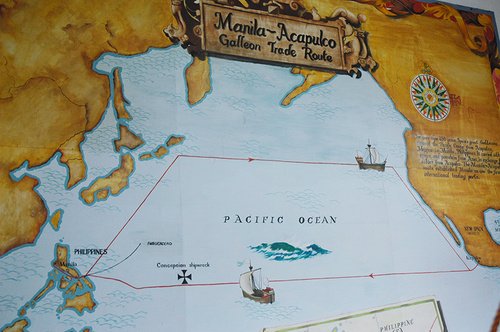
Image: Manila Galleon Trade Routes, 1573-1811. Trans Pacific Project.
Maybe the mystery ship was off course or its captain was trying to chart the coastline. Based on the wax and the many shards of Ming dynasty ceramics that have washed ashore on nearby beaches, the most likely location for the wreck site is just north of Nehalem Bay, offshore from the town of Manzanita, Oregon.
The carbon dating on the beeswax narrows the candidates. During the late 1600s and early 1700s, only two Spanish galleons went missing and have not been located yet. The Oregon wreck was first thought to be the San Francisco Xavier that disappeared in 1705, but later research showed that it was more likely to be the Santo Christo de Burgos (1693). A tsunami hit the Oregon Coast in 1700 and researchers studying its sediment layer have found pieces of pottery from the wreck, so the 1693 ship seems to be the best fit.
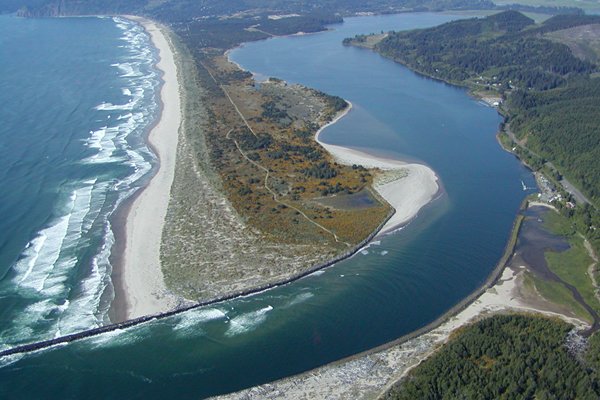
Image: The spit of coastline around Nehalem Bay. Courtesy of Kayak Tillamook.
Will these Ships Ever Be Salvaged?
We know roughly where both shipwrecks lie on the Oregon and California coasts. Researchers using modern survey tools may soon be able to pinpoint both locations. But then what? Will the ships ever be salvaged and their treasures and secrets brought to the surface?
Perhaps not.
For one thing, marine salvage law is not as simple as “finders keepers”. There is not much incentive to hunt for treasure in these cases, which is why the organizations looking for the San Agustin and the Wax Galleon are both scientific research teams rather than treasure hunters. Even if the ship’s owners are long gone and cannot be traced, the ship’s country of origin may claim ownership, as Spain did with a galleon discovered off of Florida. If the ship is being salvaged, then the salvage operator can offer the goods to the true owner and be compensated for them.
Treasure hunters would face years of court litigation to determine if they could claim any part of it, and that’s been the case even for wrecks lying in international waters far of the coastline. Control of these two shipwrecks would be messier because they probably lie in U.S. territorial waters (up to 12 miles out). So under the Abandoned Shipwreck Act of 1987, the U.S. government would have title, though it’s most likely that these wrecks would lie in the tidal portion of coastline (from the high tide line to at least three miles out) that is under control of the states.
But the obstacles do not end there. The search area for the Oregon shipwreck centers on the spit of land that lies between the ocean and Nehalem River/Bay. Analysis of the wax and porcelain on beaches suggests this is the most likely spot. And guess what? It’s an Oregon State Park. Good luck getting permission to dig up anything in a protected natural area!
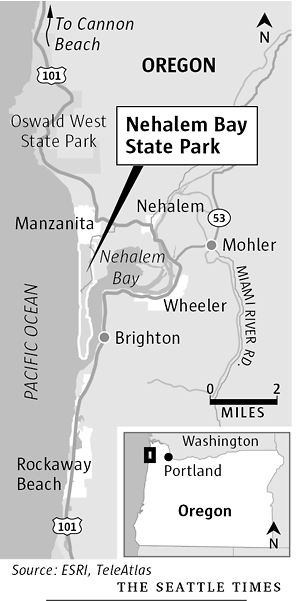
Image: Nehalem Bay State Park. The Wax Galleon is most likely to be on this protected stretch of coastline. Seattle Times.
If you think that’s messy, then take a look at the jurisdiction map for Drake’s Bay in California, site of the San Agustin shipwreck. You will see that Drake’s Bay is part of Point Reyes National Seashore (part of the U.S. National Parks Service). The water around it is located within the Gulf of the Farallones National Marine Sanctuary (U.S. National Oceanic and Atmospheric Administration). And if the wreck is located on the left side of Drake’s Bay or around the mouth of the estuary (where some pieces of iron have been found), then those waters are also a State of California Marine Reserve.
Confused? Just look at this map. I’m sure it will clear up any misunderstandings. Or not.

Image: Jurisdiction Map. Note that Drake’s Bay (top middle) is under control of multiple agencies. Public Domain.
And so the secrets of these galleons remain beneath the waves. Perhaps that is where they belong. Centuries’ worth of sea life may call them home. Any salvage or excavation would disrupt this natural balance. And perhaps that sea life is the true treasure.
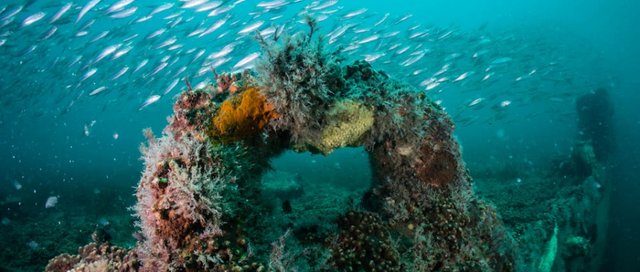
Image: Sea life covering a wreck in California. Courtesy of Channel Islands Dive Adventures.

Acknowledgements: Thanks to Richard Kaplan @steemship for assisting me with this article.
Sources:
Thumbnail image: Marin County Free Library
The San Agustin: California Shipwreck (Documentary Film), available from Thelen Creative: http://www.thelencreative.com/projects/
San Agustin Los Manila Galleon 1595 (Manila-Galleon.com): http://manila-galleon.com/treasure-ship/content/san-agustin-lost-manila-galleon-1595
California Explorers entry on Sebastian Cermeno (Captain of San Agustin): http://factcards.califa.org/exp/cermeno.html
Researcher says he knows site of 400-year old Drake’s Bay shipwreck (Marin IJ): http://www.marinij.com/article/zz/20120313/NEWS/120318910
Ship’s story revealed in 435-year old wreckage (San Francisco Chronicle): http://www.sfgate.com/bayarea/article/Ship-s-story-revealed-in-435-year-old-wreckage-2334012.php#photo-1844169
Has the Mystery of the Beeswax Wreck Been Solved? (Coast Explorer Magazine) http://coastexplorermagazine.com/features/1556-has-the-mystery-of-the-beeswax-wreck-been-solved
Beeswax from centuries old shipwrecks still found on Oregon beaches (Seattle Times): http://www.seattletimes.com/seattle-news/beeswax-from-centuries-old-shipwrecks-still-found-on-oregon-beaches/
Beeswax Wreck (Wikipedia): https://en.wikipedia.org/wiki/Beeswax_wreck
The Beeswax Wreck Project (NAGA Group): http://www.nagagroup.org/BeesWax/about/about.htm
Search for centuries old galleon off Oregon coast begins anew in Manzanita (Oregon Live): http://www.oregonlive.com/pacific-northwest-news/index.ssf/2013/08/search_for_centuries-old_galle.html
Sunken Treasure: Who Keeps the Booty? (USIA): https://usia.com/2014/07/sunken-treasure-who-keeps-the-booty/
Maritime Law Resources (LawInfo): http://resources.lawinfo.com/admiralty-maritime/are-finders-keepers-under-the-sea-what-you-ne.html
Abandoned Shipwrecks Act (Wikipedia): https://en.wikipedia.org/wiki/Abandoned_Shipwrecks_Act
Awesome post @donkeypong !
I can't even imagine...I mean if even you find a small piece of the galleon or others, the value of it is huge!
Downvoting a post can decrease pending rewards and make it less visible. Common reasons:
Submit
Dang I was all hyped to go get a submarine and find these ships. Then your last sentence made me realize that maybe they should be left alone out of respect for the sea creatures. So I guess I won't go. That and I don't have a submarine...yet!
Downvoting a post can decrease pending rewards and make it less visible. Common reasons:
Submit
Wow! I didn't know that treasure hunters can face letigations even in international waters.
Downvoting a post can decrease pending rewards and make it less visible. Common reasons:
Submit
Yes. Here is a cautionary tale even for treasure hunters operating in deep, international waters: https://www.theguardian.com/world/2012/feb/01/treasure-trove-galleon-returned-spain
Downvoting a post can decrease pending rewards and make it less visible. Common reasons:
Submit
I remember when all that went down. It was an odd case that changed precedent. If I recall correctly, the US did nothing when Spain forcefully boarded a ship flying the US flag. Too bad, if true. It turned into political maneuvering.
The Odyssey owners learned their lesson though, and make a contract with the claiming country before salvaging now.
Downvoting a post can decrease pending rewards and make it less visible. Common reasons:
Submit
Years of litigation would drain you and it's not worth the headache.
Downvoting a post can decrease pending rewards and make it less visible. Common reasons:
Submit
Interesting story... I love a good treasure hunt! :)
Downvoting a post can decrease pending rewards and make it less visible. Common reasons:
Submit
Bravo! bright post congratulations

Downvoting a post can decrease pending rewards and make it less visible. Common reasons:
Submit